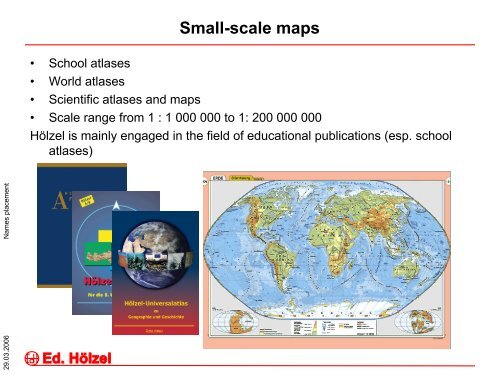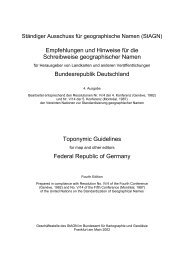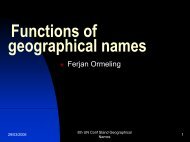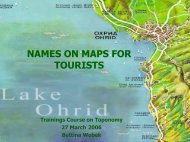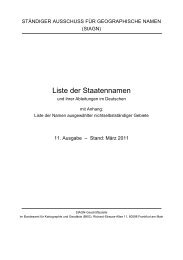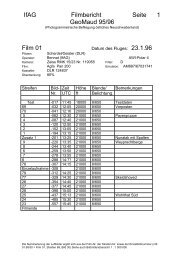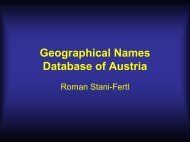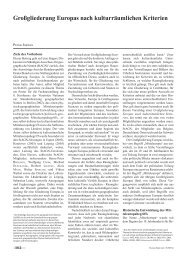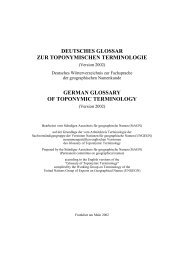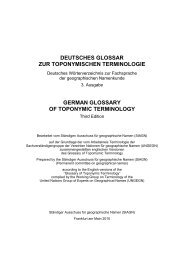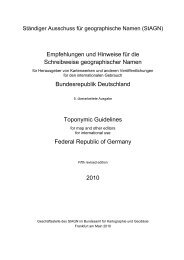Names placement on small scale maps
Names placement on small scale maps
Names placement on small scale maps
Create successful ePaper yourself
Turn your PDF publications into a flip-book with our unique Google optimized e-Paper software.
Small-<strong>scale</strong> <strong>maps</strong>• School atlases• World atlases• Scientific atlases and <strong>maps</strong>• Scale range from 1 : 1 000 000 to 1: 200 000 000Hölzel is mainly engaged in the field of educati<strong>on</strong>al publicati<strong>on</strong>s (esp. schoolatlases)29.03.2006 <str<strong>on</strong>g>Names</str<strong>on</strong>g> <str<strong>on</strong>g>placement</str<strong>on</strong>g>
First decisi<strong>on</strong>What names shall be placed <strong>on</strong> the map?general orientati<strong>on</strong> =elements of the basemaptopic<strong>scale</strong>29.03.2006 <str<strong>on</strong>g>Names</str<strong>on</strong>g> <str<strong>on</strong>g>placement</str<strong>on</strong>g>Topographic, physicalthematicdetailoverview
General orientati<strong>on</strong>• Important rivers• Important towns29.03.2006 <str<strong>on</strong>g>Names</str<strong>on</strong>g> <str<strong>on</strong>g>placement</str<strong>on</strong>g>
<str<strong>on</strong>g>Names</str<strong>on</strong>g> of topographical elementsrivers, lakes, oceansmountains, mountain rangescities and townsCOUNTRIESlandscapes29.03.2006 <str<strong>on</strong>g>Names</str<strong>on</strong>g> <str<strong>on</strong>g>placement</str<strong>on</strong>g>
29.03.2006 <str<strong>on</strong>g>Names</str<strong>on</strong>g> <str<strong>on</strong>g>placement</str<strong>on</strong>g><str<strong>on</strong>g>Names</str<strong>on</strong>g> <strong>on</strong> thematic <strong>maps</strong>Example:<str<strong>on</strong>g>Names</str<strong>on</strong>g> of highways andrailways
Types of names• independent names: not c<strong>on</strong>nected with a sign• Attributive names: c<strong>on</strong>nected with a sign29.03.2006 <str<strong>on</strong>g>Names</str<strong>on</strong>g> <str<strong>on</strong>g>placement</str<strong>on</strong>g>
Sec<strong>on</strong>d decisi<strong>on</strong>Which form of a name shall be used?Large-<strong>scale</strong>: mainly for orientati<strong>on</strong> -> names as used in the fieldSmall-<strong>scale</strong>: mainly for informati<strong>on</strong> -> different questi<strong>on</strong>s by a user, differentnames29.03.2006 <str<strong>on</strong>g>Names</str<strong>on</strong>g> <str<strong>on</strong>g>placement</str<strong>on</strong>g>Historical: name during a given time periodGeographical: today‘s name as used in geographical literatureTouristical: today‘s name as used locallyEc<strong>on</strong>omical: today‘s name as used in business languagePolitical: official namesEducati<strong>on</strong>al: different names as used in the home country of the students, inhistory, literature, science or oral traditi<strong>on</strong>Show all diacritical signs! -> Problem with some cartographic text f<strong>on</strong>ts (youneed UNICODE)
Geographical names for educati<strong>on</strong>29.03.2006 <str<strong>on</strong>g>Names</str<strong>on</strong>g> <str<strong>on</strong>g>placement</str<strong>on</strong>g>• Regulati<strong>on</strong>s by the country‘s political authorities -> e.g. ministry of educati<strong>on</strong>No official regulati<strong>on</strong>s in Austria for objects outside of Austria• Recommendati<strong>on</strong>s of scientific boardsRecommendati<strong>on</strong>s of the Austrian Working Group <strong>on</strong> Geographical <str<strong>on</strong>g>Names</str<strong>on</strong>g>(AKO), published in 1994, currently under revisi<strong>on</strong>• Recommendati<strong>on</strong>s by the United Nati<strong>on</strong>s<strong>on</strong>ly general guidelines for educati<strong>on</strong>al purposes• Other recommendati<strong>on</strong>se.g. list of country names by the ministry of foreign affairs
Recommendati<strong>on</strong>s of the AKO• Rules which nati<strong>on</strong>al languages should be used in each country• Rules how to romanize n<strong>on</strong>-Latin alphabets• List of names which should be given in their German form (ex<strong>on</strong>yms)- ex<strong>on</strong>yms in use at first positi<strong>on</strong>, end<strong>on</strong>yms in parentheses- some historical ex<strong>on</strong>yms at sec<strong>on</strong>d positi<strong>on</strong> in square brackets- The lists show the maximum of ex<strong>on</strong>yms to be used. All other namesshould be given in their end<strong>on</strong>ym form.29.03.2006 <str<strong>on</strong>g>Names</str<strong>on</strong>g> <str<strong>on</strong>g>placement</str<strong>on</strong>g>These recommendati<strong>on</strong>s have been implemented in the Austrian schoolatlases.At the moment they are under revisi<strong>on</strong> due to changes in the use of ex<strong>on</strong>yms,romanizati<strong>on</strong> rules and official languages during the last 10 years.
Third decisi<strong>on</strong>Which names can be placed <strong>on</strong> the map?2 problems:a) Space is very limited <strong>on</strong> a <strong>small</strong>-<strong>scale</strong> mapb) Too many names will distract from the map theme-> part of map generalizati<strong>on</strong>29.03.2006 <str<strong>on</strong>g>Names</str<strong>on</strong>g> <str<strong>on</strong>g>placement</str<strong>on</strong>g>1) Name can be removed without removing the object:- Independent names- Repeated names (rivers, oceans)- <str<strong>on</strong>g>Names</str<strong>on</strong>g> of some object groups (mountains, rivers, lakes)- End<strong>on</strong>ym between parentheses2) If name is removed object must be removed, too.
29.03.2006 <str<strong>on</strong>g>Names</str<strong>on</strong>g> <str<strong>on</strong>g>placement</str<strong>on</strong>g>
29.03.2006 <str<strong>on</strong>g>Names</str<strong>on</strong>g> <str<strong>on</strong>g>placement</str<strong>on</strong>g>
Forth decisi<strong>on</strong>• Where shall a name be placed?Point symbolsLine symbolsArea symbols29.03.2006 <str<strong>on</strong>g>Names</str<strong>on</strong>g> <str<strong>on</strong>g>placement</str<strong>on</strong>g>
29.03.2006 <str<strong>on</strong>g>Names</str<strong>on</strong>g> <str<strong>on</strong>g>placement</str<strong>on</strong>g>• Nearest to the symbolPoint symbols
Line symbols• Do not rotate the name more then 90°• Reading directi<strong>on</strong> is more important than flow directi<strong>on</strong>NO:YES:29.03.2006 <str<strong>on</strong>g>Names</str<strong>on</strong>g> <str<strong>on</strong>g>placement</str<strong>on</strong>g>
Area symbols – closed polyg<strong>on</strong>s• Larger objects: name inside the polyg<strong>on</strong>• Smaller objects (e.g. lakes): name outside the polyg<strong>on</strong>• If inside then space the name horiz<strong>on</strong>tally to cover the larger part of thearea29.03.2006 <str<strong>on</strong>g>Names</str<strong>on</strong>g> <str<strong>on</strong>g>placement</str<strong>on</strong>g>
Area names without clear boundaries• Name should denote the approximate extent of the object• Problem: Where are the boundaries? -> sometimes different definiti<strong>on</strong>s andopini<strong>on</strong>s, e.g. „Europe“, „Kurdistan“, „Ungarisches Tiefland“29.03.2006 <str<strong>on</strong>g>Names</str<strong>on</strong>g> <str<strong>on</strong>g>placement</str<strong>on</strong>g>
Fifth decisi<strong>on</strong>• How shall a name be placed?Interrupt lines in the same or a similarcolour!29.03.2006 <str<strong>on</strong>g>Names</str<strong>on</strong>g> <str<strong>on</strong>g>placement</str<strong>on</strong>g>The name may not overlap or touchsymbols in the same colour!Use different f<strong>on</strong>ts and sizes!
29.03.2006 <str<strong>on</strong>g>Names</str<strong>on</strong>g> <str<strong>on</strong>g>placement</str<strong>on</strong>g>Fifth decisi<strong>on</strong>• Parallel to the grid or the paper margin?
Fifth decisi<strong>on</strong>• Parallel to the grid or the paper margin?GridPaper marginMore laborious to produceEasier to produce29.03.2006 <str<strong>on</strong>g>Names</str<strong>on</strong>g> <str<strong>on</strong>g>placement</str<strong>on</strong>g><str<strong>on</strong>g>Names</str<strong>on</strong>g> can be much rotatedBetter feeling of the projecti<strong>on</strong>You can rotate the map or change theprojecti<strong>on</strong> (at least slightly) withoutredoing the names <str<strong>on</strong>g>placement</str<strong>on</strong>g>Clear reading directi<strong>on</strong>Projecti<strong>on</strong> is not supported visuallyYou have to redo the positi<strong>on</strong>ing if yourotate the map or change the projecti<strong>on</strong>
Automated names <str<strong>on</strong>g>placement</str<strong>on</strong>g>• No standard tools available for advanced graphical software• Many problems if you use a lot of names of different types in a map• You have to shift many positi<strong>on</strong>s after automatically placing the names• Problems with names al<strong>on</strong>g lines and area objects• Spacing?• Helpful if you build a new map from a names database which includesname, object type and coordinates29.03.2006 <str<strong>on</strong>g>Names</str<strong>on</strong>g> <str<strong>on</strong>g>placement</str<strong>on</strong>g>


